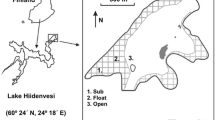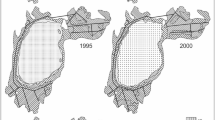Abstract
The decomposition of several lake macrophytes was investigated under field conditions. Data on weight and phosphorus loss, numbers of microbial decomposers and their activity were obtained.
Experiments were conducted in the littoral of two lakes with different levels of macrophyte development.
Weight loss during 40–60 days of decomposition for fast-decomposing plants was 60–95% and after 365-day of incubation, Potamogeton perfoliatus L. lost nearly 100% of its initial weight. Slow-decomposing plants lost 20–50% of their initial weight after 40–60 days of incubation, and Phragmites australis (Cav.) Trin. ex Steud. lost 84% of its initial weight after 365 days.
Total phosphorus content in plants did not decrease at the first stages of decomposition.
The number of microbial decomposers utilizing both labile and resistant substrates increased 2–6 times during the first 5–25 days period. During this period the community was morphologically diverse and biochemically active (high level of microbial respiration). It coincided with the highest weight loss. After that period, the number of microorganisms utilizing labile substrates, as well as the rate of decomposition decreased.
The part of macrophyte organic matter entering the biological cycle in two lakes made up 3.5% and 26% of phytoplankton primary production. Bacterial production on decomposing macrophytes was calculated at 4% and 51% of bacterioplankton production, respectively, in both lakes.
Similar content being viewed by others
References
Bastardo, H., 1979. Laboratory studies on decomposition of littoral plants. Pol. Arch. Hydrobiol. 26: 267–299.
Birch, P. B., J. O. Gabrielson & K. S. Hamel, 1983. Decomposition of Cladophora. I. Field studies in the Peel-Harvey Estuarine system, Western Australia. Bot. mar. 26: 165–171.
Davis, G. B. & A. G. Van der Valk, 1983. Uptake and release of nutrients by living and decomposing Typha glauca Gogr. tissues at Eagle Lake. Aquat. Bot. 16: 75–89.
Denisova, I. A., 1989. Produkcia makrofitov. (Macrophyte production). In V. G. Drabkova & E. A. Stravinskaja (eds), Transformacia organicheskovo veschestva i biogennih elementov pri antropogennom evtrofirovanii ozer. (Transformation of organic matter and nutrients during the antropogenic eutrophication of lakes) (in Russian) The ‘Nauka’ Publ., Leningrad: 72–78.
Drabkova, V. G., 1981. Zonalnoe izmenenie intensivnosti mikrobiologicheskih processov v ozerah. (in Russian). (Regional changes of the intensivity of microbiological processes in lakes). The ‘Nauka’ Publ., Leningrad: 212 pp.
Fenchel, T. & P. Harrison, 1976. The significance of bacterial grazing and mineral cycling for the decomposition of particulate detritus. In J. M. Anderson & A. Macfadyen (eds), The role of terrestrial and aquatic organisms in decomposition processes. Oxford: 285–299.
Godshalk, G. L. & R. G. Wetzel, 1978. Decomposition of aquatic angiosperms. 2. Particulate components. Aquat. Bot. 5: 301–327.
Golterman, H. L., 1975. Physiological Limnology. Elsevier Publ. Comp., Amsterdam, Oxford, N.Y., 489 pp.
Hill, B. H., T. J. Gardner & O. F. Ekisola, 1988. Breakdown of gallery forest leaf litter in intermittent and perenial prairie streams. S. West Nat. 33: 323–331.
Huber, A. L., J. O. Gabrielson, P. J. Dolin & D. K. Kidby, 1983. Decomposition of Cladophora. III. Heterotroph populations and phosphatase activity associated with in vitro phosphorus mineralization. Bot. mar. 26: 181–188.
Katanskaja, V. M., 1988. Vishaja vodnaja rastitelnost. (Water Macrophyte). In I. S. Trifonova (ed.), Metodicheskie aspekti limnologicheskovo monitoringa. (Methodological aspects of limnological monitoring) (in Russian). The ‘Nauka’ Publ., Leningrad: 102–113.
Kudriavtsev, V. M. & N. A. Kudriavtseva, 1985. Razlozenie camisha ozernovo v litorali Ribinskovo vodohranilischa. (Decomposition of Scirpus lacustris L. in littoral of Ribinsk reservoir) (In Russian). Gidrobiol. J. 21: 49–51.
Mason, C. F. & R. J. Bryant, 1975. Production, nutrient content and decomposition of Phragmites communis Trin. and Typha angustifolia L. J. Ecol. 63: 71–96.
Matthews, C. P. & A. Kowalczewski, 1969. Disappearance of litter and its contribution to production to the River Thames. J. Ecol. 57: 543–552.
Pritkova, M. J., I. S. Boiko, L. N. Varentsov, I. I. Velikoretskaja & K. N. Kupetskaja, 1989. Geografo-gidrologicheskaja harakteristika ozer. (Geography and hydrology of lakes). In V. G. Drabkova & E. A. Stravinskaja (eds) Transformacia organicheskovo veschestva i biogennih elementov pri antropogennom evtrofirovanii ozer. (Transformation of organic matter and nutrients during the antropogenic eutrophication of lakes) (in Rusian). The ‘Nauka’ Publ., Leningrad: 5–14.
Seki, H. & O. D. Kennedy, 1969. Marine bacteria and other heterotrophs as food for zooplankton in the Strait of Georgia during the winter. J. Fish Res. Bd Can. 26: 3165–3173.
Smock, L. A. & D. L. Stoneburner, 1980. The response of macroinverterbrates to aquatic macrophyte decomposition. Oikos. 35: 397–403.
Trifonova, I. S., 1988. Vvedenie. (Introduction). In I. S. Trifonova (ed.), Metodicheskie aspekti limnologicheskovo monitoringa. (Methodological aspects of limnological monitoring) (in Russian). The ‘Nauka’ Publ., Leningrad: 5–8.
Trifonova, I. S., 1989. Soderzanie chlorofilla, skorost producirovania organicheskovo veshestva phitoplanktonom v ozerah s raznim urovnem koncentracji biogennih elementov. (Chlorofill concentration and rates of organic mattern production and nutrients during antropogenic eutrophication of lakes). In V. G. Drabkova & E. A. Stravinskaja (eds), Transformacia organicheskovo veschestva i biogennih elementov pri antropogennom evtrofirovanii ozer. (Transformation of organic matter and nutrients during the antropogenic eutrophication of lakes) (In Russian). The ‘Nauka’ Publ., Leningrad, 212 pp.
Author information
Authors and Affiliations
Rights and permissions
About this article
Cite this article
Belova, M. Microbial decomposition of freshwater macrophytes in the littoral zone of lakes. Hydrobiologia 251, 59–64 (1993). https://doi.org/10.1007/BF00007165
Issue Date:
DOI: https://doi.org/10.1007/BF00007165




